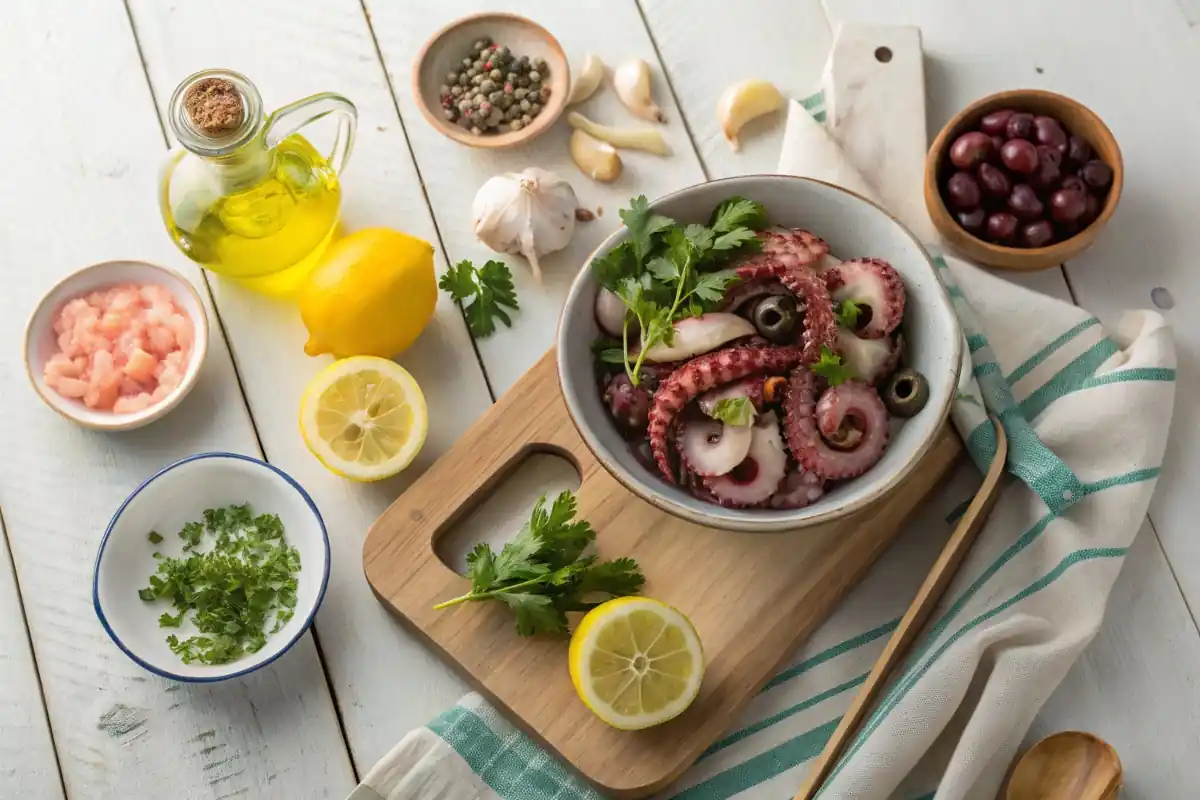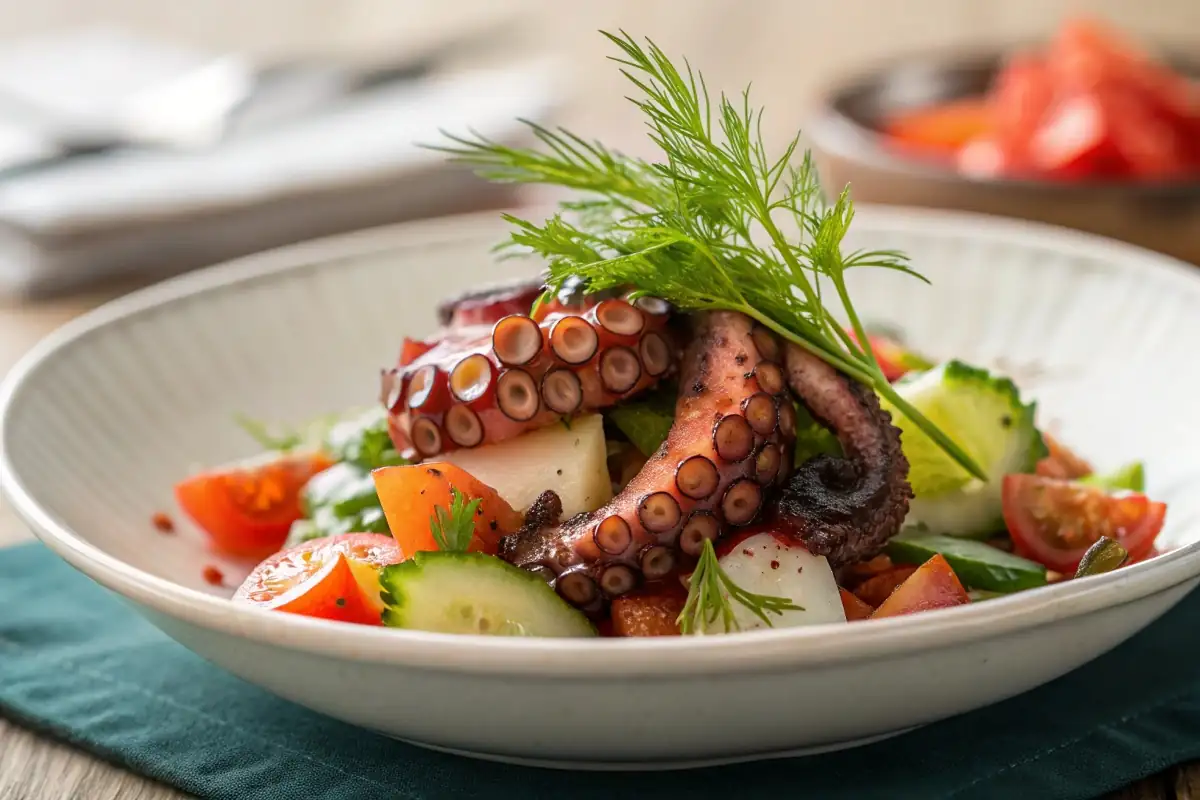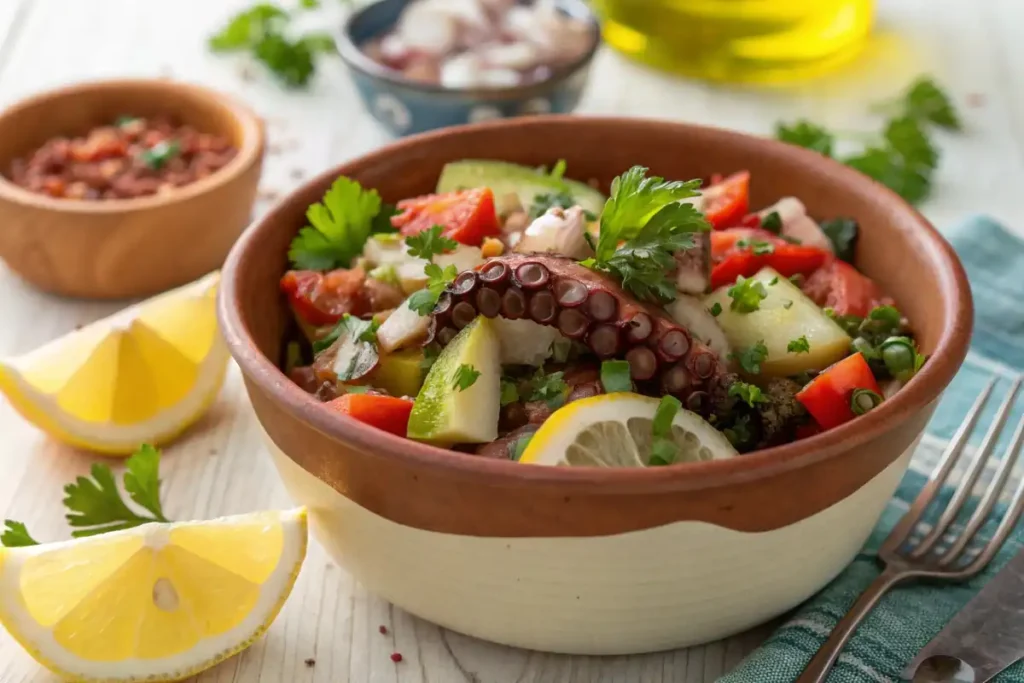Enjoy a refreshing octopus salad. This simple recipe brings the taste of the sea to your table. Perfect for a light lunch or appetizer!
Looking for a delicious and unique seafood dish? This octopus salad recipe is easy to make and bursting with flavor. It’s a delightful combination of tender octopus, fresh vegetables, and a zesty dressing. You will love it!
What is Octopus Salad?
Octopus salad is a popular dish, especially in Mediterranean countries. It typically features boiled or grilled octopus, cut into bite-sized pieces and mixed with a variety of fresh additions. Common additions include lemon juice, olive oil, garlic, parsley, and other seasonings. It is often served cold or at room temperature. This makes it a perfect meal during warm weather.
A Brief History
The use of octopus in cooking dates back centuries. Coastal cultures have long valued it as a food source. Octopus salad recipes have evolved over time. Each region adds its unique twist with different additions and spices. The simplicity and freshness remain at its core.
Why You’ll Love This Recipe
This octopus salad is not only delicious, but it is also relatively simple to prepare. It’s perfect for those who want to enjoy a gourmet meal without spending hours in the kitchen.
- Easy to make: The steps are straightforward.
- Fresh ingredients: This salad highlights the freshness of the sea.
- Healthy: Octopus is a good source of proteins.
- Versatile: It can be served as a starter, a light lunch, or part of a larger spread.
- Flavorful: A combination of savory, tangy, and refreshing flavors.

Ingredients:
To make this flavorful octopus salad, gather these key ingredients:
- 1 pound octopus, cleaned
- 1/2 cup olive oil
- 1/4 cup lemon juice
- 2 cloves garlic, minced
- 1/4 cup fresh parsley, chopped
- 1/4 cup red onion, thinly sliced
- 1/2 cup celery, diced
- 1/2 cup Kalamata olives, pitted and halved
- Salt and pepper to taste
- Optional: Red pepper flakes for a little heat
Diving Deeper into Key Ingredients
Let’s explore each ingredient to understand their role. This will help you create the best possible octopus salad.
- Octopus: The star of the dish! Choose wisely for optimal freshness and texture.
- Olive Oil: Use good quality extra virgin olive oil. It adds a rich flavor and silky texture to the dressing.
- Lemon Juice: Fresh lemon juice is key for brightness. Avoid bottled juice.
- Garlic: Mince it finely to distribute the flavor evenly.
- Parsley: Fresh parsley adds a refreshing herbal note.
- Red Onion: Thinly sliced red onion provides a sharp, pungent flavor. Soak in cold water for a milder taste.
- Celery: Diced celery adds crunch and a subtle refreshing taste.
- Kalamata Olives: These olives offer a briny, salty flavor that compliments the octopus.
- Salt and Pepper: Essential for seasoning. Use sea salt for a more complex flavor.
- Red Pepper Flakes: Add a pinch for a little heat and depth.

How to Cook Octopus for Salad
Cooking octopus can seem intimidating, but it’s actually quite simple. The goal is to achieve a tender texture.
- Tenderizing: Some people recommend tenderizing octopus by beating it against a hard surface. This helps break down the proteins and prevents it from becoming too chewy.
- Boiling: Place the octopus in a large pot and cover it with water. Bring to a boil, then reduce heat and simmer for 45-60 minutes, or until tender. A fork should easily pierce the thickest part of the octopus.
- Cooling: Let the octopus cool in the cooking liquid. This helps it retain moisture. Once cool enough to handle, cut it into bite-sized pieces.
Step-by-Step Boiling Instructions
Here is a more detailed step-by-step guide to boiling octopus:
- Cleaning: Rinse the octopus thoroughly under cold water. Remove the beak (the hard, central part where the tentacles meet) and the ink sac, if present.
- Choosing a Pot: Use a large pot that can comfortably hold the octopus and enough water to cover it completely.
- Adding Aromatics (Optional): For extra flavor, you can add aromatics to the boiling water. Consider bay leaves, peppercorns, or a halved onion.
- Boiling: Bring the water to a boil. Gently lower the octopus into the boiling water.
- Simmering: Reduce the heat to a gentle simmer. Cover the pot and cook for 45-60 minutes, or until the octopus is tender. Check for freshness.
- Testing for Tenderness: Use a fork to test for tenderness. The fork should easily pierce the thickest part of the octopus.
- Cooling: Turn off the heat and let the octopus cool in the cooking liquid. This helps it retain moisture.
Tips for Selecting Octopus
- Freshness is Key: Look for octopus that smells fresh and has a firm texture. Avoid octopus that smells fishy or feels slimy.
- Frozen Octopus: If you can’t find fresh octopus, frozen is a good choice. Thaw it overnight in the fridge before cooking.
- Size Matters: Smaller octopus tends to be more tender than larger ones.
Alternative Cooking Methods
- Grilling: Grilling adds a smoky flavor. Marinate the octopus first. Grill over medium heat until tender, about 10-15 minutes.
- Sous Vide: This method ensures even cooking. Cook the octopus at 170°F (77°C) for 2-3 hours.
- Pressure Cooker: A pressure cooker can significantly reduce cooking time. Follow the manufacturer’s instructions for octopus.
Grilling Octopus: A Detailed Guide
If you choose to grill your octopus, follow these steps:
- Marinating: Marinate the octopus for at least 30 minutes before grilling. A simple marinade can consist of olive oil, lemon juice, garlic, and herbs.
- Preparing the Grill: Preheat your grill to medium heat. Make sure the grates are clean and lightly oiled.
- Grilling: Place the marinated octopus on the grill. Grill for 10-15 minutes, turning occasionally, until tender and slightly charred.
- Checking for Doneness: The octopus is done when it is tender and slightly charred.
- Resting: Let the grilled octopus rest for a few minutes before cutting it into pieces for the salad.
Assembling the Octopus Salad: Step-by-Step
Now that you have your cooked octopus, it’s time to assemble the salad.
- Combine Octopus and Vegetables: In a large bowl, mix the cut octopus, red onion, celery, and Kalamata olives.
- Make the Dressing: In a small bowl, whisk together olive oil, lemon juice, minced garlic, salt, pepper, and red pepper flakes (if using).
- Dress the Salad: Pour the dressing over the octopus and vegetable mixture. Toss gently to combine.
- Chill: Cover the bowl and refrigerate for at least 30 minutes to allow the flavors to meld.
- Serve: Before serving, sprinkle with fresh parsley.
Perfecting the Dressing
The dressing is what brings the octopus salad together. Here are some tips for making the best dressing:
- Use Fresh Ingredients: Always use fresh lemon juice and garlic for the best flavor.
- Emulsify the Dressing: Whisk the olive oil and lemon juice together vigorously until they are emulsified. This creates a creamy, harmonious dressing.
- Taste and Adjust: Taste the dressing and adjust the seasoning as needed. You may want to add more lemon juice for brightness, salt for balance, or pepper for a little kick.
- Add Herbs: Experiment with different herbs in the dressing. Oregano, thyme, or dill can add a unique flavor dimension.
Tips for the Best Flavor
- Marinate: Letting the salad marinate in the dressing for a few hours or overnight enhances the flavor.
- Adjust Seasoning: Taste and adjust the seasoning as needed. You may want to add more lemon juice for brightness or salt for balance.
- Serve Cold: This salad is best served cold or at room temperature.

Delicious Variations of Octopus Salad
The beauty of octopus salad lies in its adaptability. You can easily customize it to your taste.
- Mediterranean Octopus Salad: Add tomatoes, cucumber, and feta cheese for a classic Mediterranean twist.
- Spicy Octopus Salad: Increase the amount of red pepper flakes or add a splash of hot sauce for a spicy kick.
- Italian Octopus Salad: Incorporate capers, oregano, and a touch of balsamic vinegar for an Italian flavor profile.
- Citrus Octopus Salad: Use a combination of lemon, lime, and orange juice in the dressing for a refreshing citrusy flavor.
- Grilled Octopus Salad: Grill the octopus before adding it to the salad for a smoky taste.
- Potato Octopus Salad: Add boiled and diced potatoes for a more substantial meal.
- Beans and Octopus Salad: Combine beans such as white beans or chickpeas to create a hearty and delicious flavor.
Adding a Personal Touch: Creative Variations
Don’t be afraid to experiment with different additions and flavors. Here are a few more ideas to spark your creativity:
- Avocado Octopus Salad: Add diced avocado for a creamy texture and rich flavor.
- Mango Octopus Salad: Incorporate diced mango for a sweet and tropical twist.
- Jalapeño Octopus Salad: Add finely chopped jalapeño for a spicy kick.
- Fennel Octopus Salad: Thinly sliced fennel provides a refreshing anise flavor.
- Quinoa Octopus Salad: Combine quinoa for a heartier meal and add proteins.
Making it Your Own
Feel free to experiment with different vegetables, herbs, and seasonings. Some other additions to try include bell peppers, carrots, dill, mint, or even a pinch of sumac.
Serving Suggestions
Octopus salad can be served in many ways. Here are a few ideas:
- Appetizer: Serve it as an appetizer before a meal.
- Light Lunch: Enjoy it as a light and satisfying lunch.
- Side Dish: Pair it with grilled fish or chicken.
- On Crackers: Serve it on crackers or crostini for a simple and elegant snack.
- In a Sandwich: Use it as a filling for sandwiches or wraps.
Elevated Presentation Ideas
The way you present your octopus salad can enhance the dining experience. Here are a few ideas for an elevated presentation:
- Individual Bowls: Serve the salad in individual bowls for an elegant touch.
- Garnish: Garnish with fresh herbs, lemon wedges, or a drizzle of olive oil.
- Layered Presentation: Layer the salad in a glass jar or bowl to show off the different ingredients.
- Use edible flowers: Add color and an elevated presentation.
Perfect Pairings
- Wine: A crisp white wine, such as Sauvignon Blanc or Pinot Grigio, compliments the flavors of the salad.
- Bread: Serve with crusty bread for soaking up the delicious dressing.
- Drinks: A refreshing lemonade or sparkling water also pairs well.
Exploring Wine Pairings in Detail
Choosing the right wine can greatly enhance your octopus salad experience. Here’s a more detailed guide:
- Sauvignon Blanc: Its citrusy notes and high acidity complement the tanginess of the lemon dressing.
- Pinot Grigio: A light-bodied, dry white wine that won’t overpower the delicate flavors of the octopus.
- Vermentino: A Mediterranean white wine with herbal notes and a slightly salty finish that pairs perfectly with seafood.
- Rosé: A dry rosé from Provence can also be a good choice, especially if the salad has a spicy element.
Health Benefits of Octopus
Octopus is not only tasty, but it also offers several health benefits.
- High in Proteins: Proteins are essential for building and repairing tissues.
- Rich in Nutrients: Octopus contains important nutrients such as iron, vitamin B12, and selenium.
- Low in Fat: It is a lean source of protein.
- Source of Omega-3 Fatty Acids: These fats are beneficial for heart health.
- Rich in minerals: Octopus provides minerals essential to the human body.
A Closer Look at Nutritional Value
Let’s examine the nutrients found in octopus in more detail:
- Iron: Essential for carrying oxygen in the blood.
- Vitamin B12: Important for nerve function and red blood cell production.
- Selenium: An antioxidant that helps protect cells from damage.
- Omega-3 Fatty Acids: Beneficial for heart health and brain function.
- Copper: Helps in the formation of red blood cells and supports the immune system.
Considerations
While octopus is generally healthy, it’s important to be mindful of a few things:
- Cholesterol: Octopus contains cholesterol. People with high cholesterol should consume it in moderation.
- Sodium: Depending on how it’s prepared, octopus salad can be high in sodium. Be mindful of salt levels.
- Allergies: Seafood allergies are common. Individuals with seafood allergies should avoid octopus.
Making it a Conscious Choice
If you’re health-conscious, here are a few tips for making your octopus salad even healthier:
- Use Olive Oil Sparingly: Olive oil is healthy, but it is also high in calories. Use it in moderation.
- Load Up on Vegetables: Add plenty of fresh vegetables to your salad for extra nutrients.
- Choose Lower-Sodium Options: Use lower-sodium olives and limit the amount of salt you add.
Sourcing Sustainable Octopus
As consumers become increasingly aware of environmental issues, it’s important to consider the sustainability of the seafood we eat. Here are a few things to keep in mind when sourcing octopus:
- Look for Sustainable Certifications: Check for certifications that indicate the octopus was harvested sustainably.
- Choose Local When Possible: Sourcing octopus locally can reduce the carbon footprint of your meal.
- Ask Questions: Don’t be afraid to ask your fishmonger about the sourcing of their octopus.
Supporting Responsible Fisheries
By making conscious choices about the octopus we buy, we can encourage responsible fishing practices and help protect marine ecosystems.
Octopus Salad: A Culinary Adventure
Octopus salad is a delightful dish that brings a taste of the ocean to your table. With its simple preparation, fresh ingredients, and flexible recipe, it’s a great choice for any occasion. So, gather your ingredients, follow these tips, and enjoy a refreshing and flavorful octopus salad! Exploring different variations can lead to a memorable culinary experience!
Frequently Asked Questions (FAQs)
Is octopus salad healthy?
Yes, octopus salad can be a healthy choice. It is rich in proteins and nutrients, and low in fat. Balance it with fresh vegetables for an even better choice.
Is octopus tasty to eat?
Many people find octopus to be very tasty. The texture can be tender and slightly chewy, and the flavor is mild and slightly sweet. Proper cooking is essential for the best taste.
What flavors go well with octopus?
Refreshing flavors like lemon, garlic, and parsley compliment octopus very well. Other compatible flavors include olives, capers, and oregano.
How do you cook octopus so it’s not chewy?
The key to cooking tender octopus is to either cook it quickly over high heat or slowly over low heat. Simmering it for 45-60 minutes usually does the trick. Tenderizing before cooking can also help.

